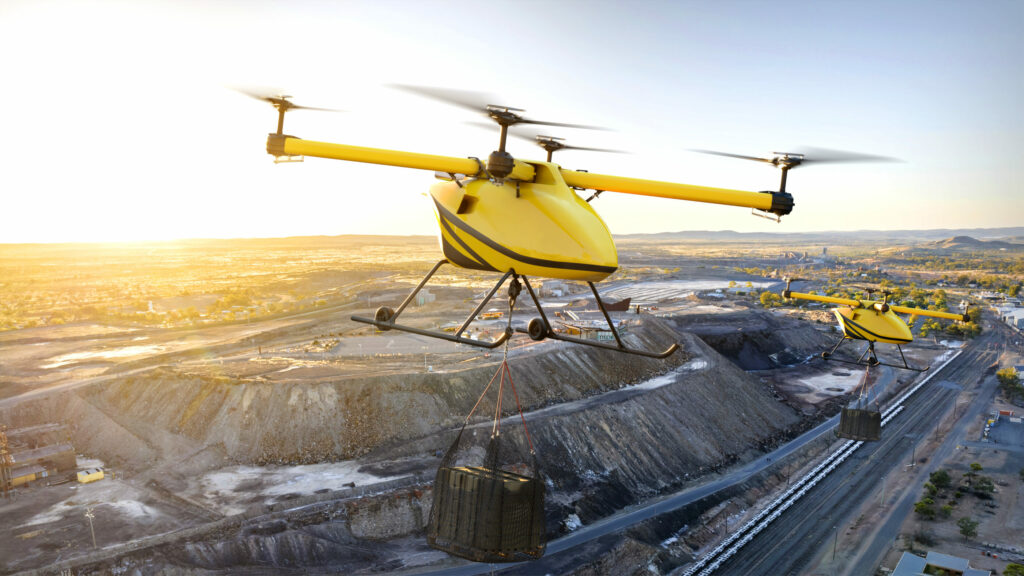Kaman Air Vehicles, a division of Kaman Corporation, today announced a long-term commercial partnership with PHI Aviation, a division of PHI Inc., to develop its KARGO UAV program for commercial operations. In addition to working closely with Kaman to develop the autonomous UAV, PHI has committed to purchasing 50 aircraft.

The KARGO UAV utilizes a quadcopter design, Rolls-Royce 300 engine, and options for either a belly cargo pod or sling load capability to deliver cargo as far as 500 nautical miles. The aircraft’s payload capacity extends to 800 lb. With onboard autonomy software being developed by Near Earth Autonomy, the aircraft is designed to be piloted either remotely or fully autonomous.
“We are thrilled to be entering into and announcing a long-term commercial agreement with PHI,” said Carrol Lane, senior vice president of Kaman Corporation and president of the air vehicles and precision products segments of the company. “We surveyed the landscape for prospective partners who we believe have an operator’s mindset — an organization that truly understands flight safety and regulatory requirements, as well as an organization that can span the entire value stream from a commercial rotorcraft operation. We couldn’t be happier with who we chose to bring the KARGO UAV as a commercial product into the marketplace.”
Kaman began development of the KARGO UAV in 2021 and flew a scaled demonstrator in the fall of that year. In October 2022, the U.S. Marine Corps announced it selected Kaman Air Vehicles to build a funded military logistics UAS prototype of the KARGO UAV. Kaman is well underway in developing the prototype to military specification (MIL-SPEC), which includes full autonomous capability. The commercial partnership plan is to take what is developed for the military and modify it for the civilian industry.
“There’s a lot of buzz out there around diversification, especially into unmanned systems markets,” said Keith Mullett, managing director of PHI Aviation. “We are pursuing this diversification and new technology in ways that make use of our core capabilities, who we are as an organization, why people contract with us, and what customers value when they choose PHI. This decision is very much in line with that. Also, last year, we launched our global sustainability plan and clearly part of that is making decisions that are going to complement the energy transition and also preserve the long-term sustainability of our business regardless of what energy customers we’re supporting in the future.”
PHI consulted with its core customers and will actively involve them in the design and production phases to ensure the final product will meet the needs of its customers. “We are confident that the KARGO UAV from Kaman is the most applicable system in the UAV space for our core customers and the markets we serve,” Mullett added.

Mullett is adamant the KARGO UAV will not replace the company’s current manned rotorcraft. It is meant to supplement operations and perform duties that are either not safe or economical for helicopters, he said. For offshore oil-and-gas as well as wind farms, these uses include transporting vital tools and supplies immediately to offshore locations, or even between locations, when a helicopter is not scheduled, does not have the room, or cannot fly due to weather. The KARGO UAV can also use an onboard camera system to perform inspections of rigs and wind turbines, reducing risks to pilots, he said.
Other uses include transporting supplies across austere and expansive terrain for mineral exploration and mining companies, transporting supplies between hospitals, assisting in search-and-rescue missions, and delivering humanitarian aid for disaster relief.
The aircraft may or may not look exactly as it does for the military, Lane said. In addition to designing it to serve commercial needs, plans include developing the aircraft so it can be easily updated with new technology, such as electrification, as it becomes available.
Kaman and PHI are hopeful the aircraft will be certified and flying commercially within three to four years. Lane emphasized PHI’s strong relationships with regulatory agencies, developed through its years of experience in receiving certifications, as an integral part of the partnership and the companies’ aggressive timeline. The price for the aircraft has not yet been set and the value of the 50-aircraft order was not disclosed given final development and production prices are unknown, Mullett said.
A mock-up of the Kaman KARGO UAV is on display at the Kaman booth at HAI Heli-Expo 2023, booth #B5620.









